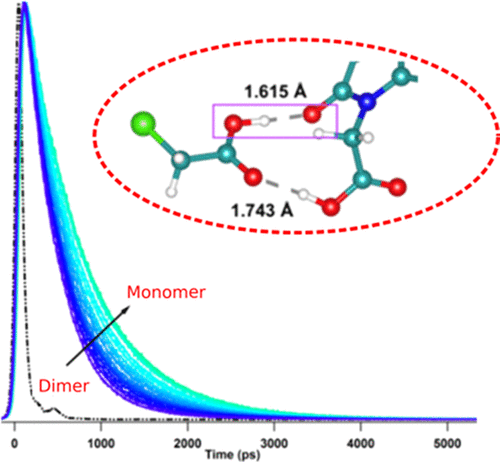当前位置:
X-MOL 学术
›
J. Phys. Chem. C
›
论文详情
Our official English website, www.x-mol.net, welcomes your feedback! (Note: you will need to create a separate account there.)
Critical Role of Protons for Emission Quenching of Indoline Dyes in Solution and on Semiconductor Surfaces
The Journal of Physical Chemistry C ( IF 3.7 ) Pub Date : 2020-09-08 , DOI: 10.1021/acs.jpcc.0c07099 Ahmed M. El-Zohry 1, 2 , Saurabh Agrawal 3 , Filippo De Angelis 3, 4, 5 , Mariachiara Pastore 6 , Burkhard Zietz 1
The Journal of Physical Chemistry C ( IF 3.7 ) Pub Date : 2020-09-08 , DOI: 10.1021/acs.jpcc.0c07099 Ahmed M. El-Zohry 1, 2 , Saurabh Agrawal 3 , Filippo De Angelis 3, 4, 5 , Mariachiara Pastore 6 , Burkhard Zietz 1
Affiliation

|
By combining time-correlated single photon counting (TCSPC) measurements, density functional theory (DFT), and time-dependent DFT (TD-DFT) calculations, we herein investigate the role of protons, in solutions and on semiconductor surfaces, for the emission quenching of indoline dyes. We show that the rhodanine acceptor moieties, and in particular the carbonyl oxygens, undergo protonation, leading to nonradiative excited-state deactivation. The presence of the carboxylic acid anchoring group, close to the rhodanine moiety, further facilitates the emission quenching, by establishing stable H-bond complexes with carboxylic acid quenchers, with high association constants, in both ground and excited states. This complexation favors the proton transfer process, at a low quencher concentration, in two ways: bringing close to the rhodanine unit the quencher and assisting the proton release from the acid by a partial-concerted proton donation from the close-by carboxylic group to the deprotonated acid. Esterification of the carboxylic group, indeed, inhibits the ground-state complex formation with carboxylic acids and thus the quenching at a low quencher concentration. However, the rhodanine moiety in the ester form can still be the source of emission quenching through dynamic quenching mechanism with higher concentrations of protic solvents or carboxylic acids. Investigating this quenching process on mesoporous ZrO2, for solar cell applications, also reveals the sensitivity of the adsorbed excited rhodanine dyes toward adsorbed protons on surfaces. This has been confirmed by using an organic base to remove surface protons and utilizing cynao-acrylic dye as a reference dye. Our study highlights the impact of selecting such acceptor group in the structural design of organic dyes for solar cell applications and the overlooked role of protons to quench the excited state for such chemical structures.
中文翻译:

质子在溶液中和半导体表面上吲哚染料的猝灭中的关键作用
通过结合时间相关的单光子计数(TCSPC)测量,密度泛函理论(DFT)和时间相关DFT(TD-DFT)计算,我们在本文中研究质子在溶液中和半导体表面上对于发射的作用。吲哚啉染料的淬灭。我们表明,若丹宁受体部分,特别是羰基氧,经历质子化,导致非辐射激发态失活。接近若丹宁部分的羧酸锚定基团的存在,通过与羧酸猝灭剂建立稳定的H键结合基态和激发态的高缔合常数,进一步促进了发射猝灭。这种络合通过两种方式有利于低淬灭剂浓度下的质子转移过程:将淬灭剂靠近若丹宁单元,并通过从邻近的羧基向去质子化的酸提供部分折衷的质子供体来帮助质子从酸中释放出来。实际上,羧基的酯化抑制了与羧酸的基态络合物的形成,因此抑制了在低淬灭剂浓度下的淬灭。但是,酯形式的若丹宁部分仍然可以通过动态猝灭机制以更高浓度的质子溶剂或羧酸进行发射猝灭。研究中孔ZrO的淬灭过程 抑制与羧酸形成基态络合物,从而在低淬灭剂浓度下淬灭。但是,酯形式的若丹宁部分仍然可以通过动态猝灭机制以更高浓度的质子溶剂或羧酸进行发射猝灭。研究中孔ZrO的淬灭过程 抑制了与羧酸形成基态络合物的生成,从而抑制了低淬灭剂浓度下的淬灭。但是,酯形式的若丹宁部分仍然可以通过动态猝灭机制以更高浓度的质子溶剂或羧酸进行发射猝灭。研究中孔ZrO的淬灭过程2,对于太阳能电池应用,也揭示朝向上表面吸附的质子吸附兴奋绕丹宁染料的灵敏度。通过使用有机碱去除表面质子并使用cynao-丙烯酸染料作为参考染料已证实了这一点。我们的研究强调了在太阳能电池应用有机染料的结构设计中选择此类受体基团的影响,以及质子对此类化学结构的激发态淬灭的忽略作用。
更新日期:2020-10-02
中文翻译:

质子在溶液中和半导体表面上吲哚染料的猝灭中的关键作用
通过结合时间相关的单光子计数(TCSPC)测量,密度泛函理论(DFT)和时间相关DFT(TD-DFT)计算,我们在本文中研究质子在溶液中和半导体表面上对于发射的作用。吲哚啉染料的淬灭。我们表明,若丹宁受体部分,特别是羰基氧,经历质子化,导致非辐射激发态失活。接近若丹宁部分的羧酸锚定基团的存在,通过与羧酸猝灭剂建立稳定的H键结合基态和激发态的高缔合常数,进一步促进了发射猝灭。这种络合通过两种方式有利于低淬灭剂浓度下的质子转移过程:将淬灭剂靠近若丹宁单元,并通过从邻近的羧基向去质子化的酸提供部分折衷的质子供体来帮助质子从酸中释放出来。实际上,羧基的酯化抑制了与羧酸的基态络合物的形成,因此抑制了在低淬灭剂浓度下的淬灭。但是,酯形式的若丹宁部分仍然可以通过动态猝灭机制以更高浓度的质子溶剂或羧酸进行发射猝灭。研究中孔ZrO的淬灭过程 抑制与羧酸形成基态络合物,从而在低淬灭剂浓度下淬灭。但是,酯形式的若丹宁部分仍然可以通过动态猝灭机制以更高浓度的质子溶剂或羧酸进行发射猝灭。研究中孔ZrO的淬灭过程 抑制了与羧酸形成基态络合物的生成,从而抑制了低淬灭剂浓度下的淬灭。但是,酯形式的若丹宁部分仍然可以通过动态猝灭机制以更高浓度的质子溶剂或羧酸进行发射猝灭。研究中孔ZrO的淬灭过程2,对于太阳能电池应用,也揭示朝向上表面吸附的质子吸附兴奋绕丹宁染料的灵敏度。通过使用有机碱去除表面质子并使用cynao-丙烯酸染料作为参考染料已证实了这一点。我们的研究强调了在太阳能电池应用有机染料的结构设计中选择此类受体基团的影响,以及质子对此类化学结构的激发态淬灭的忽略作用。


























 京公网安备 11010802027423号
京公网安备 11010802027423号